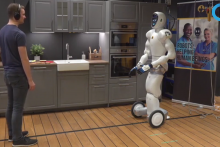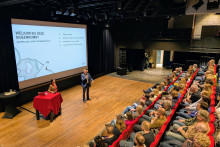Team i-Botics includes members from universities, research institutes and companies. Among them are five scientists from the Human Media Interaction and Robotics and Mechatronics groups at the University of Twente: Jan van Erp, Gwenn Englebienne, Camille Sallaberry, Sara Falcone, Douwe Dresscher and Robin Lieftink. Together they are developing an advanced avatar system with which an operator can see, hear, and interact within a remote environment in a manner that feels as if they are truly there.
About XPRIZE
XPRIZE is a large international competition involving development of many ground-breaking technologies. The first XPRIZE was given out in the domain of private spaceflight and led to launch of companies such as SpaceX and Virgin Galactic. The Dutch team is participating in the $10M ANA Avatar XPRIZE to create an avatar system. The total prize value is ten million dollars, with the main winner receiving five million and the rest divided among other finalists.
Becoming the robot
‘Imagine a humanoid robot that you can fully control,’ explains UT professor Jan van Erp and lead scientist of the i-Botics team. ‘You operate the robotic avatar from a special cockpit, a cabin that closes off your local environment, while the robot can be anywhere else in the world. Through the system, you essentially become the robot and it copies what you are doing, all your motions and facial expressions. That way we can transport human presence to a remote location in real time. There is no physical barrier of space and time anymore.’
Team i-Botics showcasing their overall goals for XPRIZE
‘There are two scenarios we use as guidelines for development,’ continues Van Erp. ‘One providing expertise at distance, such as maintenance or disaster relief. The other is visiting a remote relative, caring for them over distance. However, you could even use this system for a business meeting. If you are at the university and I’m on the other side of the world, I could crawl into the avatar and have a personal meeting with you as a robotic presence.’
See, hear, feel and smell
The avatar system is still under development, but it is ‘pretty far along’, says the Van Erp. ‘Our partner in Norway (Halodi Robotics) builds humanoid robots and our partner in Switzerland (ETH Zurich) develops ANYmal, a quadrupedal robot that is able to work in challenging environments – all that gives us a head start. The Dutch partners are working on the operator’s side. Our ultimate goal is for the operator to be able to fully immersed in the remote environment. We want to be able to project the video, audio, but also smells, the temperature and touch, so you truly feel as if you are there. Our avatar system has arms and hands comparable to human skills. The control station has an advanced haptic feedback system, so you feel the force on your arms and fingers and you are able to pick up and manipulate objects.’
The team's semifinals submission video demonstrating how their robotic avatar works
Being able to manipulate objects is one of the requirements to succeed in the ANA Avatar XPRIZE competition. ‘For example, you need to be able to play a game together as an operator and recipient. We should be able to sit down and play chess together. I should be able to move the pieces through the robotic system,’ explains the UT scientist.
The team now has several months to tweak their ‘creation’. They have been selected as one of the 38 teams from sixteen countries to advance as Semifinalist Teams; and they will present their avatar system at the ANA Avatar XPRIZE competition held in autumn in the US. If their technology impresses the judging panel, they can advance to the Finals in Summer 2022. The ultimate winner will take home five million dollars.
Team i-Botics
The team includes members from the following partners: The University of Twente, research institute TNO, university ETH Zurich, and companies Sensiks, Haption and Halodi.







